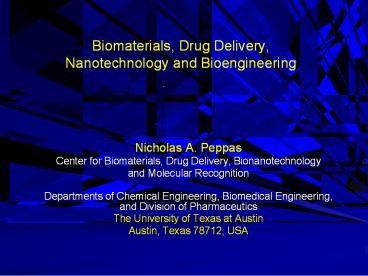Biomaterials, Drug Delivery, Nanotechnology and Bioengineering - PowerPoint PPT Presentation
Title:
Biomaterials, Drug Delivery, Nanotechnology and Bioengineering
Description:
... Oral Delivery of Proteins Complexation and pH Responsive Hydrogels Slide 5 In Vivo Study with pH-Responsive Complexation Hydrogels Slide 7 Slide 8 ... – PowerPoint PPT presentation
Number of Views:279
Avg rating:3.0/5.0
Title: Biomaterials, Drug Delivery, Nanotechnology and Bioengineering
1
Biomaterials, Drug Delivery, Nanotechnology and
Bioengineering
- Nicholas A. Peppas
- Center for Biomaterials, Drug Delivery,
Bionanotechnology - and Molecular Recognition
- Departments of Chemical Engineering, Biomedical
Engineering, - and Division of Pharmaceutics
- The University of Texas at Austin
- Austin, Texas 78712, USA
2
Smart Drug Delivery
- The future of drug delivery systems will involve
smart systems - These will address the issue of keeping the drug
at the desired therapeutic level in the body thus
avoiding frequent administration - Systems use detection of chemical signals in the
body to prompt the release of drugs - The ultimate goal is to administer drugs at the
right time, at the right dose anywhere in the
body with specificity and efficiency
3
Oral Delivery of Proteins
- Challenges
- Protection of the drug from
- The acidic environment in the stomach
- Degradation by proteolytic enzymes in the GI
tract - Penetration and absorption of drug across the
intestinal mucosa and epithelium
4
Complexation and pH Responsive Hydrogels
Complexed Small mesh size Low pH
Protect drug
Release drug
Uncomplexed Increased mesh size High pH
x
5
(No Transcript)
6
In Vivo Study with pH-Responsive Complexation
Hydrogels
- P(MAA-g-EG) microspheres loaded with insulin
- Administered to diabetic rats? 40 drop in blood
glucose levels
7
NIH 2-3 positions
8
NIH/NCI 1-2 positions
9
NSF 1 position
10
(No Transcript)
11
System-Responsive TherapyControl-Based Design
of Biomedical Systems Configurational Biomimetic
Imprinting
Making artificial locks for molecular keys
- Molecular key
- (template molecule)
- Small molecules
- Drug substances, amino acids, steroid hormones
- Large molecules
- Nucleic acids, proteins
- Cells and viruses
- Lock
- (polymer building blocks)
- Functional monomers
- Cross-linkers
12
Configurational Biomimetic Imprinting
Polymerization
Template
Extraction and drying
13
BioMEMS Sensor Platform
- Pattern environmentally responsive hydrogels onto
silicon microcantilevers to create a BioMEMS/MEMS
sensor device.
14
(No Transcript)
15
System-Responsive TherapyA Bright Future
- Need for advanced intelligent materials, more
reliable devices, miniaturized systems - Society asks for improved treatment of disease,
advanced detection and therapy, and cost
effective processes - Improvement of quality of life is important
16
(No Transcript)
17
David
Bill
Cody
Brandon
Maggie
Diane
Jenny
Amey
Mary
Cancer
Insulin
siRNA
Recognitive
External Triggering































